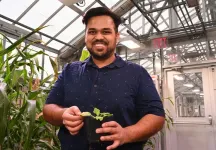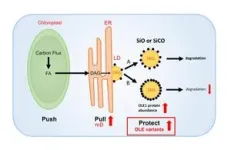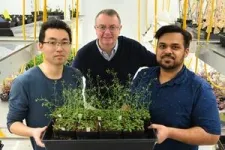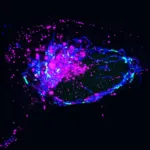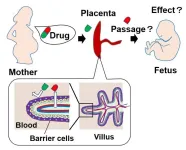(Press-News.org) UPTON, NY—Biologists at the U.S. Department of Energy’s (DOE) Brookhaven National Laboratory have demonstrated a new way to boost the oil content of plant leaves and seeds. As described in the journal New Phytologist, the scientists identified and successfully altered key portions of a protein that protects newly synthesized oil droplets. The genetic alterations essentially protect the oil-protector protein so more oil can accumulate.
“Implementing this strategy in bioenergy or oil crop plants could help meet the growing demand for biodiesel fuel and/or nutritionally important plant oils,” said Brookhaven Lab biochemist John Shanklin, chair of the Lab’s Biology Department, who led the research.
Shanklin’s team has been working for years to boost plant oil accumulation, particularly in parts of plants such as leaves that generally don’t make a lot of oil. These vegetative tissues typically account for most of the plant biomass. Boosting their ability to accumulate oil would substantially increase the biomass energy content. And since vegetable oils are key feedstocks for making biodiesel, the strategy could turn crop plants into green factories for producing sustainable fuels.
Push, pull, protect
Much of the Brookhaven team’s focus has been implementing genetic strategies that biochemically push plant cells to make more oil and pull that newly synthesized oil into storage in lipid droplets—rather than shuttling it into building new plant parts.
“But once oil is made, it can be broken down, and the level of accumulation is the balance between synthesis and breakdown,” Shanklin explained.
So, the scientists have also used a third approach: cranking up production proteins that protect lipid droplets from being degraded.
One such protective protein naturally made by plants is known as oleosin. Oleosin becomes embedded in the oil-droplet membrane, blocking access to enzymes called lipases that initiate the breakdown of oil.
“We and others typically ramp up levels of this small protein to protect the lipid droplets,” Shanklin said.
But oleosin itself can be degraded, limiting its effectiveness. So, in the new work, Shanklin and his team set out to find a way to protect the oil protector.
“This was a complicated puzzle that lead author Sanket Anaokar worked creatively to solve,” Shanklin said. Anaokar is a Brookhaven Lab research associate in the Center for Advanced Bioenergy and Bioproducts Innovation (CABBI) program, a DOE-funded Bioenergy Research Center led by the University of Illinois Urbana-Champaign.
Deleting degradation signals
“We reasoned that if we could identify and remove the parts of oleosin that the degradation enzymes recognize—the degradation ‘signals’—we could get oleosin to stick around and enhance oil accumulation,” Anaokar said.
Using clues from other groups that had used a different approach to tackle this problem, the scientists engineered variants of the oleosin protein and tested their effects in tobacco leaves. The team initially designed the variants to change all the amino acids hypothesized to be involved in the degradation of oleosin. Then, they reverted the mutations back one at a time and looked for the biggest changes in oil accumulation. In the end, this allowed them to identify a few key mutations that made oleosin significantly more resistant to breakdown.
“These changes made the variant forms of oleosin accumulate to higher levels—which in turn more efficiently protected the oil, so the oil levels also rose,” Shanklin said.
Plants expressing the most successful mix of genetic modifications accumulated 54% more oil in their leaves and 13% more in their seeds compared to unmodified plants.
Serendipitous surprise
One surprising finding was that the modifications to protect oil droplets did not have negative effects on plant growth or the ability of the seeds to germinate. This was surprising because plant seeds need to break down stored oil to fuel germination and the early stages of seedling growth —that is, until the plant has established itself and grown enough leaves for photosynthesis to kick in and fuel further growth.
“We initially had concerns that preventing oil breakdown during seed development would inhibit this ‘establishment’ process,” Shanklin said. “But we discovered that establishment is unaffected by the oleosin variants. This tells us that, during early growth, the plant uses another mechanism for breaking down oil so seedlings can get access to its stored energy.
“We don’t yet know what that process is, but it allows us to use oleosin variants to increase oil accumulation in vegetative tissue and seeds without impairing seedling growth,” Shanklin said.
This research was supported by the DOE Office of Science, via CABBI. It was initiated with support from the Renewable Oil Generated with Ultra-productive Energycane (ROGUE) program, also led by the University of Illinois. In addition to the biochemical and genetic studies in plants, the team used confocal microscopy at Brookhaven Lab’s Center for Functional Nanomaterials (CFN), a DOE Office of Science user facility.
Brookhaven National Laboratory is supported by the Office of Science of the U.S. Department of Energy. The Office of Science is the single largest supporter of basic research in the physical sciences in the United States and is working to address some of the most pressing challenges of our time. For more information, visit science.energy.gov.
Follow @BrookhavenLab on social media. Find us on Instagram, LinkedIn, X, and Facebook.
Related Links
Scientific paper: "The expression of genes encoding novel Sesame oleosin variants facilitates enhanced triacylglycerol accumulation in Arabidopsis leaves and seeds"
With Extra Sugar, Leaves Get Fat Too
Scientists ID Sterol Essential for Oil Accumulation in Plants
Engineering Duckweed to Produce Oil for Biofuels, Bioproducts END
Protecting the protector boosts plant oil content
Scientists demonstrate new genetic strategy for preventing breakdown of plant oils needed for biofuels and other products
2024-02-08
ELSE PRESS RELEASES FROM THIS DATE:
Physical activity is insufficient to counter cardiovascular risk associated with sugar-sweetened beverage consumption
2024-02-08
Québec, February 8, 2024 - Contrary to popular belief, the benefits of physical activity do not outweigh the risks of cardiovascular disease associated with drinking sugar-sweetened beverages, according to a new study led by Harvard T. H. Chan School of Public Health. Jean-Philippe Drouin-Chartier, professor at Université Laval’s Faculty of Pharmacy, was a co-author.
Sugar-sweetened beverages are the largest source of added sugars in the North American diet. Their consumption is associated with ...
CARB-X funds Visby Medical to develop a portable rapid diagnostic for gonorrhea including antibiotic susceptibility
2024-02-08
(BOSTON: Thursday, February 8, 2024) – Combating Antibiotic-Resistant Bacteria Biopharmaceutical Accelerator (CARB-X) will award up to US$1.8 million to biotechnology company, Visby Medical, to develop a portable rapid polymerase chain reaction (PCR) diagnostic to detect the presence of the pathogen that causes gonorrhea, Neisseria gonorrhoeae (NG), and its susceptibility to ciprofloxacin, a former frontline oral antibiotic that can no longer treat resistant NG. A rapid result on when ciprofloxacin may be effective could enable physicians to treat gonorrhea patients with confidence, while reserving ceftriaxone, the only antibiotic that remains effective against resistant NG.
Visby ...
Fusion research facility JET’s final tritium experiments yield new energy record
2024-02-08
GARCHING and OXFORD (8 February 2024) –
The Joint European Torus (JET), one of the world’s largest and most powerful fusion machines, has demonstrated the ability to reliably generate fusion energy, whilst simultaneously setting a world-record in energy output.
These notable accomplishments represent a significant milestone in the field of fusion science and engineering.
In JET's final deuterium-tritium experiments (DTE3), high fusion power was consistently produced for 5 seconds, resulting in a ground-breaking record of 69 megajoules using a mere 0.2 milligrams of fuel.
JET is a tokamak, a design which uses powerful ...
A new “metal swap” method for creating lateral heterostructures of 2D materials
2024-02-08
Electronically conducting two-dimensional (2D) materials are currently hot topics of research in both physics and chemistry owing to their unique properties that have the potential to open up new avenues in science and technology. Moreover, the combination of different 2D materials, called heterostructures, expands the diversity of their electrical, photochemical, and magnetic properties. This can lead to innovative electronic devices not achievable with a single material alone.
Heterostructures can be fabricated in two ways: vertically, with materials ...
Study visually captures a hard truth: Walking home at night is not the same for women
2024-02-08
An eye-catching new study shows just how different the experience of walking home at night is for women versus men.
The study, led by Brigham Young University public health professor Robbie Chaney, provides clear visual evidence of the constant environmental scanning women conduct as they walk in the dark, a safety consideration the study shows is unique to their experience.
Chaney and co-authors Alyssa Baer and Ida Tovar showed pictures of campus areas at four Utah universities — Utah Valley University, ...
Ice cores provide first documentation of rapid Antarctic ice loss in the past
2024-02-08
Researchers from the University of Cambridge and the British Antarctic Survey have uncovered the first direct evidence that the West Antarctic Ice Sheet shrunk suddenly and dramatically at the end of the Last Ice Age, around eight thousand years ago.
The evidence, contained within an ice core, shows that in one location the ice sheet thinned by 450 metres — that’s more than the height of the Empire State Building — in just under 200 years.
This is the first evidence anywhere in Antarctica for such a fast loss of ice. Scientists are worried that today’s rising temperatures ...
Faulty DNA disposal system causes inflammation
2024-02-08
LA JOLLA (February 8, 2024)—Cells in the human body contain power-generating mitochondria, each with their own mtDNA—a unique set of genetic instructions entirely separate from the cell’s nuclear DNA that mitochondria use to create life-giving energy. When mtDNA remains where it belongs (inside of mitochondria), it sustains both mitochondrial and cellular health—but when it goes where it doesn’t belong, it can initiate an immune response that promotes inflammation.
Now, Salk scientists ...
Breaking through barriers
2024-02-08
Researchers from Tokyo Medical and Dental University (TMDU) overcome scientific roadblocks and develop a model to assess the biology of the human placental barrier
Tokyo, Japan – During pregnancy, the human placenta plays multiple essential roles, including hormone production and nutrient/waste processing. It also serves as a barrier to protect the developing fetus from external toxic substances. However, the placental barrier can still be breached by certain drugs. In a recent article published in Nature Communications, a team led by researchers ...
Patterns of brain connectivity differ between pre-term and term babies
2024-02-08
Under strict embargo until 10.00 GMT Thursday 8 February 2024
A new King’s College London scanning study of 390 babies has shown distinct patterns between term and pre-term babies in the moment-to-moment activity and connectivity of brain networks.
Supported by Wellcome and the National institute of Health and Care Research (NIHR) Maudsley Biomedical Research Centre, this is the first study to analyse how the communication between brain areas changes moment-to-moment in the first few weeks of life.
Published in Nature Communications, the study also found that these dynamic ...
Social science: White actors featured more than non-white actors on American film posters
2024-02-08
White actors are featured more frequently and more prominently on posters for American-produced films than non-white actors despite recent increases in the representation of actors from other ethnic groups, according to a study published in Humanities and Social Sciences Communications.
Galit Fuhrmann Alpert and colleagues investigated trends in the ethnic diversity of actors featured on over 45,000 posters advertising over 24,000 English-speaking films produced in the USA between 1960 and 2021. Actors were assigned to one of four ethnic groups; white, Black, Indian, or Asian using an algorithm trained on the FairFace image dataset, which contains equal numbers ...
LAST 30 PRESS RELEASES:
Shark biology breakthrough: Study tracks tiger sharks to Maui mating hub
Mysterious iron ‘bar’ discovered in famous nebula
World-first tool reduces harmful engagement with AI-generated explicit images
Learning about public consensus on climate change does little to boost people’s support for action, study shows
Sylvester Cancer Tip Sheet for January 2026
The Global Ocean Ship-Based Hydrographic Investigations Program (GO-SHIP) receives the Ocean Observing Team Award
Elva Escobar Briones selected for The Oceanography Society Mentoring Award
Why a life-threatening sedative is being prescribed more often for seniors
Findings suggest that certain medications for Type 2 diabetes reduce risk of dementia
UC Riverside scientists win 2025 Buchalter Cosmology Prize
SETI Institute opens call for nominations for the 2026 Tarter Award
Novel theranostic model shows curative potential for gastric and pancreatic tumors
How beige fat keeps blood pressure in check
Fossils reveal ‘latitudinal traps’ that increased extinction risk for marine species
Review: The opportunities and risks of AI in mental health research and care
New map reveals features of Antarctic’s ice-covered landscape
Beige fat promotes healthy vascular function and blood pressure in mice
Chronic low-dose pesticide exposure reduces the life span of wild lake fish, China-based study shows
Tiny earthquakes reveal hidden faults under Northern California
Long-term pesticide exposure accelerates aging and shortens lifespan in fish
Professor Tae-Woo Lee's research group develops groundbreaking perovskite display technology demonstrating the highest efficiency and industry-level operational lifetime
The “broker” family helps tidy up the cell
Ecology: Mummified cheetahs discovery gives hope for species’ Arabic reintroduction
Researchers survey the ADHD coaching boom
Air pollution and cardiac remodeling and function in patients with breast cancer
Risk of suicide in patients with traumatic injuries
Post–intensive care syndrome
The lifesaving potential of opioid abatement funds
The Frontiers of Knowledge Award goes to Allan MacDonald and Pablo Jarillo-Herrero for their discovery of the “magic angle” enabling science to transform and control the behavior of new materials
Discovery reveals how keto diet can prevent seizures when drugs fail
[Press-News.org] Protecting the protector boosts plant oil contentScientists demonstrate new genetic strategy for preventing breakdown of plant oils needed for biofuels and other products
